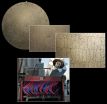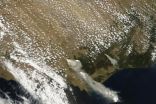(Press-News.org) The Third Sloan Digital Sky Survey (SDSS-III) has issued Data Release 9 (DR9), the first public release of data from the Baryon Oscillation Spectroscopic Survey (BOSS). In this release BOSS, the largest of SDSS-III's four surveys, provides spectra for 535,995 newly observed galaxies, 102,100 quasars, and 116,474 stars, plus new information about objects in previous Sloan surveys (SDSS-I and II).
"This is just the first of three data releases from BOSS," says David Schlegel of the U.S. Department of Energy's Lawrence Berkeley National Laboratory (Berkeley Lab), an astrophysicist in the Lab's Physics Division and BOSS's principal investigator. "By the time BOSS is complete, we will have surveyed more of the sky, out to a distance twice as deep, for a volume more than five times greater than SDSS has surveyed before – a larger volume of the universe than all previous spectroscopic surveys combined."
Spectroscopy yields a wealth of information about astronomical objects including their motion (called redshift and written "z"), their composition, and sometimes also the density of the gas and other material that lies between them and observers on Earth. The BOSS spectra are now freely available at http://sdss3.org to a public that includes amateur astronomers, astronomy professionals who are not members of the SDSS-III collaboration, and high-school science teachers and their students.
The new release lists spectra for galaxies with redshifts up to z = 0.8 (roughly 7 billion light years away) and quasars with redshifts between z = 2.1 and 3.5 (from 10 to 11.5 billion light years away). When BOSS is complete it will have measured 1.5 million galaxies and at least 150,000 quasars, as well as many thousands of stars and other "ancillary" objects for scientific projects other than BOSS's main goal.
The key to the history of the universe
BOSS is designed to measure baryon acoustic oscillation (BAO), the large-scale clustering of matter in the universe. BAO began as rippling fluctuations ("sound waves") in the hot, dense soup of matter and radiation that made up the early universe. As the universe expanded it cooled. Finally atoms formed and radiation went its own way; the density ripples left their marks as temperature variations in the cosmic microwave background (CMB), where they can be detected today.
The CMB came into being 380,000 years after the big bang, over 13.6 billion years ago, and continues to stretch across the entire sky as the universe expands. Peaks in CMB temperature variation occur about half a billion light years apart, at the same angle, viewed from Earth, as peaks in the large-scale galactic structure that evolved billions of years later. The regions of higher density in the CMB were in fact the sources of galaxy formation; they correspond to regions where galaxies cluster, along with intergalactic gas and concentrations of much more massive underlying dark matter. The natural "standard ruler" marking peaks in clustering can be applied not only across the sky but in all three dimensions, backward in time to the CMB.
Distant quasars provide another way of measuring BAO and the distribution of matter in the universe. Quasars are the brightest objects in the distant universe, whose spectra bristle with individually shifted absorption lines, a "Lyman-alpha forest" unique to each that reveals the clumping of intergalactic gas and underlying dark matter between the quasar and Earth.
Marks on the cosmic ruler
Schlegel has called BAO "an inconveniently sized ruler," requiring "a huge volume of the universe just to fit the ruler inside," but it's a precision tool for tracking the universe's expansion history, and for probing the nature of gravity and the mysterious dark energy that's causing expansion to accelerate.
To fill the huge volume, BOSS had to find more and fainter objects in the sky at greater distances than SDSS had attempted before. The camera system and spectrographs of the 2.5-meter Sloan Foundation Telescope at the Apache Point Observatory in New Mexico had to be completely rebuilt.
SDSS uses "plug plates" at the telescope's focal plane, aluminum disks with holes drilled to match the precise position of previously imaged target objects. SDSS-I and II plug plates had only 640 holes apiece, each covering three arcseconds; BOSS is using 2,000 plug plates with 1,000 holes apiece, each covering a tight two arcseconds to reduce light that's not from the target.
Optical fibers are plugged into the holes every day by hand, to guide the light from each target to a spectrograph. While weather conditions vary night to night, observations on the best nights use up to nine plug plates. For BOSS, the spectrographs were rebuilt with new optics and new CCD detectors designed and fabricated at Berkeley Lab.
"Light from distant galaxies arrives at Earth redshifted into the infrared," says Natalie Roe, director of Berkeley Lab's Physics Division and BOSS's instrument scientist, who led construction of the spectrographs. "We optimized the BOSS spectrographs for mapping exactly these galaxies."
Working with Schlegel and Adam Bolton at the University of Utah, Berkeley Lab's Stephen Bailey is in charge of daily "extraction pipeline" operations that convert raw data from the telescope into useful spectra and quantities derived from them, ready for scientific analysis. Data storage and the extraction pipeline run on the Riemann Linux cluster of Berkeley Lab's High-Performance Computing Services Group; the data is copied from Riemann to the University of Utah, New York University, Johns Hopkins University, and the National Energy Research Scientific Computing Center (NERSC) at Berkeley Lab. The Lab also hosts the SDSS-III website, http://sdss3.org, from which the data can be downloaded.
"Data releases are a proud tradition for SDSS, and the first BOSS data greatly increase the SDSS store of information," Bailey says. "Members of the SDSS-III collaboration get first crack at it – with barely enough time to write up their results – but three times as many papers based on the data are published by scientists outside the collaboration."
Says Schlegel, "SDSS-III is already the most used of all surveys from any telescope in the world, including the Keck telescopes and the Hubble Space Telescope. With DR9, BOSS contributes a huge information increase for all kinds of scientific investigations, from quasars to how stars evolve to really odd objects like galaxy-scale strong gravitational lenses. Meanwhile the BOSS BAO survey is over two-thirds finished, and ahead of schedule – we're well on our way to the best measure of BAO that will be made for a long time. All the data BOSS collects will be available to anyone who can use it."
INFORMATION:
"The Ninth Data Release of the Sloan Digital Sky Survey: First Spectroscopic Data from the SDSS-III Baryon Oscillation Spectroscopic Survey," by Christopher Ahn et al, has been submitted to the Astrophysical Journal Supplement and may be found on the arXiv preprint server at http://arxiv.org/abs/1207.7137.
"The Baryon Oscillation Spectroscopic Survey of SDSS-III," by Kyle Dawson, David Schlegel et al, has been submitted to the Astronomical Journal and may be found on the arXiv preprint server at http://arxiv.org/abs/1208.0022.
"Spectral Classification and Redshift Measurement for the SDSS-III Baryon Oscillation Spectroscopic Survey," by Adam Bolton et al, has been submitted to the Astronomical Journal and may be found on the arXiv preprint server at http://arxiv.org/abs/1207.7326
References to these and other papers relating to Data Release 9 are in the SDSS-III Collaboration release at http://www.sdss3.org/press/. Berkeley Lab researchers who are members of BOSS and contributed to these papers include Stephen Bailey, William Carithers, Andreu Font-Ribera, Jessica Kirkpatrick, Beth Reid, Natalie Roe, Nicholas Ross, David Schlegel, and Martin White.
Lawrence Berkeley National Laboratory addresses the world's most urgent scientific challenges by advancing sustainable energy, protecting human health, creating new materials, and revealing the origin and fate of the universe. Founded in 1931, Berkeley Lab's scientific expertise has been recognized with 13 Nobel prizes. The University of California manages Berkeley Lab for the U.S. Department of Energy's Office of Science. For more, visit www.lbl.gov.
DOE's Office of Science is the single largest supporter of basic research in the physical sciences in the United States, and is working to address some of the most pressing challenges of our time. For more information, please visit the Office of Science website at science.energy.gov/.
Funding for SDSS-III has been provided by the Alfred P. Sloan Foundation, the Participating Institutions, the National Science Foundation, and the U.S. Department of Energy Office of Science. The SDSS-III web site is http://www.sdss3.org.
SDSS-III is managed by the Astrophysical Research Consortium for the Participating Institutions of the SDSS-III Collaboration including the University of Arizona, the Brazilian Participation Group, Brookhaven National Laboratory, University of Cambridge, Carnegie Mellon University, University of Florida, the French Participation Group, the German Participation Group, Harvard University, the Instituto de Astrofisica de Canarias, the Michigan State/Notre Dame/JINA Participation Group, Johns Hopkins University, Lawrence Berkeley National Laboratory, Max Planck Institute for Astrophysics, Max Planck Institute for Extraterrestrial Physics, New Mexico State University, New York University, Ohio State University, Pennsylvania State University, University of Portsmouth, Princeton University, the Spanish Participation Group, University of Tokyo, University of Utah, Vanderbilt University, University of Virginia, University of Washington, and Yale University.
The first public data release from BOSS, the Baryon Oscillation Spectroscopic Survey
Led by Berkeley Lab scientists, the Sloan Digital Sky Survey’s BOSS is bigger than all other spectroscopic surveys combined for measuring the universe's large-scale structure
2012-08-08
ELSE PRESS RELEASES FROM THIS DATE:
EARTH: Shake, rattle and roll
2012-08-08
Alexandria, VA – A team of researchers may have discovered a way to hear earthquakes. Not the noises of rattling windows and crumbling buildings, but the real sounds an earthquake makes deep underground as rock grinds and fails catastrophically. Typical seismic waves have frequencies below the audible range for humans, but the August issue of EARTH shows you where to find the voice of one seismic monster: the March 11, 2011, magnitude-9.0 Tohoku earthquake in Japan.
Beyond the novelty of simply hearing an earthquake, the team found that the new technology could possibly ...
UK hotel industry alive with innovation
2012-08-08
Large hotel chains are quick to adopt and adapt innovations developed in other industries, while smaller hotels make almost continual incremental changes in response to customers' needs. The UK hotel industry is alive with innovation and new ways of improving service for customers, research funded by the Economic and Social Research Council (ESRC) has found.
The findings of a project led by Professor Gareth Shaw of Exeter University and Professor Allan Williams of Surrey University run counter to the traditional image of the hotel sector as slow to change. Official measures ...
Unusual weather events identified during the Black Saturday bushfires
2012-08-08
Research has revealed that the extremely hot, dry and windy conditions on Black Saturday combined with structures in the atmosphere called 'horizontal convective rolls' -similar to streamers of wind flowing through the air - which likely affected fire behaviour.
The study is the first of its kind to produce such detailed, high-resolution simulations of weather patterns on the day and provides insights for future fire management and warning systems.
The work was led by Dr Todd Lane and Ms Chermelle Engel from The University of Melbourne with Prof Michael Reeder (Monash ...
Benefit of PET and PET/CT in ovarian cancer is not proven
2012-08-08
Due to the lack of studies, there is currently no proof that patients with ovarian cancer can benefit from positron emission tomography (PET) alone or in combination with computed tomography (CT). As regards diagnostic accuracy, in certain cases, recurrences can be detected earlier and more accurately with PET or PET/CT than with conventional imaging techniques. This is the conclusion of the final report by the German Institute for Quality and Efficiency in Health Care (IQWiG) in Cologne that was published on 23 May 2012.
More reliable diagnosis is supposed to improve ...
Queen's University Belfast makes significant cancer breakthrough
2012-08-08
A major breakthrough by scientists at Queen's University Belfast could lead to more effective treatments for throat and cervical cancer.
The discovery could see the development of new therapies, which would target the non-cancerous cells surrounding a tumour, as well as treating the tumour itself.
Researchers at Queen's Centre for Cancer Research and Cell Biology have found that the non-cancerous tissue, or 'stroma', surrounding cancers of the throat and cervix, plays an important role in regulating the spread of cancer cells.
The discovery opens the door for the development ...
Scientists discover the truth behind Colbert's 'truthiness'
2012-08-08
Trusting research over their guts, scientists in New Zealand and Canada examined the phenomenon Stephen Colbert, comedian and news satirist, calls "truthiness"—the feeling that something is true. In four different experiments they discovered that people believe claims are true, regardless of whether they actually are true, when a decorative photograph appears alongside the claim. The work is published online in the Springer journal, Psychonomic Bulletin & Review.
"We wanted to examine how the kinds of photos people see every day—the ones that decorate newspaper or TV ...
Humanities mini-courses for doctors sharpen thinking and creativity
2012-08-08
Mini-courses designed to increase creative stimulation and variety in physicians' daily routines can sharpen critical thinking skills, improve job satisfaction and encourage innovative thinking, according to Penn State College of Medicine researchers who piloted a series of such courses.
"For decades, career development theory has identified a stage that occurs at midlife, characterized by a desire to escape the status quo and pursue new ventures," said Kimberly Myers, Ph.D., associate professor of humanities. "It is increasingly clear that these mid-career professionals ...
Berlin beats London and Washington in league table of world's best democratic space
2012-08-08
New research from the University of Warwick suggests that Berlin has the best democratic space in the world, topping a list that includes London, Washington and Tokyo.
The list appears in a new book, 'Democracy and Public Space: The Physical Sites of Democratic Performance' written by Dr John Parkinson, from the University of Warwick's Politics and International Studies department.
Dr Parkinson carefully selected 11 capital cities and assessed how well they provide space for all kinds of democratic action. He visited Berlin, Washington, Ottawa, Canberra, Wellington, ...
Cichlid fish: How does the swim bladder affect hearing?
2012-08-08
"Sound vibrations are transmitted to the inner ear via anterior extensions of the swim bladder or via bony ossicles", the biologist Tanja Schulz-Mirbach explains how swim bladders may serve for hearing. The hearing sensitivity improves considerably in this way. The anterior part of the swim bladder functions in specialized fish species similar to an ear drum. Up to now the effects of the different swim bladder morphologies have not been investigated in detail in cichlid fishes. The behavioural biologists of the University of Vienna Tanja Schulz-Mirbach and Friedrich Ladich ...
New 3D map of massive galaxies and black holes offers clues to dark matter, dark energy
2012-08-08
Astronomers have constructed the largest-ever three-dimensional map of massive galaxies and distant black holes, which will help the investigation of the mysterious "dark matter" and "dark energy" that make up 96 percent of the universe.
The map was produced by the Sloan Digital Sky Survey III (SDSS-III).
Early last year, the SDSS-III released the largest-ever image of the sky, which covered one-third of the night sky. The new data, "Data Release 9" (DR9), which publically releases the data from the first two years of this six-year project, begins expansion of this ...
LAST 30 PRESS RELEASES:
Researchers identify gene that calms the mind and improves attention in mice
Artificial metabolism turns waste CO2 into useful chemicals
Ancient sea anemone sheds light on animal cell type evolution
Begging gene leads to drone food
How climate policies that incentivize and penalize can drive the clean energy transition
Can community awareness campaigns in low-resource areas improve early diagnosis of colorectal cancer?
Stardust study resets how life’s atoms spread through space
Practical education: Clinical scenario-based program development
The impact of family dynamics on eating behaviour – how going home for Christmas can change how you eat
Tracing the quick synthesis of an industrially important catalyst
New software sheds light on cancer’s hidden genetic networks
UT Health San Antonio awarded $3 million in CPRIT grants to bolster cancer research and prevention efforts in South Texas
Third symposium spotlights global challenge of new contaminants in China’s fight against pollution
From straw to soil harmony: International team reveals how biochar supercharges carbon-smart farming
Myeloma: How AI is redrawing the map of cancer care
Manhattan E. Charurat, Ph.D., MHS invested as the Homer and Martha Gudelsky Distinguished Professor in Medicine at the University of Maryland School of Medicine
Insilico Medicine’s Pharma.AI Q4 Winter Launch Recap: Revolutionizing drug discovery with cutting-edge AI innovations, accelerating the path to pharmaceutical superintelligence
Nanoplastics have diet-dependent impacts on digestive system health
Brain neuron death occurs throughout life and increases with age, a natural human protein drug may halt neuron death in Alzheimer’s disease
SPIE and CLP announce the recipients of the 2025 Advanced Photonics Young Innovator Award
Lessons from the Caldor Fire’s Christmas Valley ‘Miracle’
Ant societies rose by trading individual protection for collective power
Research reveals how ancient viral DNA shapes early embryonic development
A molecular gatekeeper that controls protein synthesis
New ‘cloaking device’ concept to shield sensitive tech from magnetic fields
Researchers show impact of mountain building and climate change on alpine biodiversity
Study models the transition from Neanderthals to modern humans in Europe
University of Phoenix College of Doctoral Studies releases white paper on AI-driven skilling to reduce burnout and restore worker autonomy
AIs fail at the game of visual “telephone”
The levers for a sustainable food system
[Press-News.org] The first public data release from BOSS, the Baryon Oscillation Spectroscopic SurveyLed by Berkeley Lab scientists, the Sloan Digital Sky Survey’s BOSS is bigger than all other spectroscopic surveys combined for measuring the universe's large-scale structure


